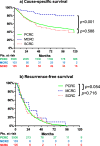Retrospective study of prognosis of patients with multiple colorectal carcinomas: synchronous versus metachronous makes the difference
- PMID: 33855608
- PMCID: PMC8195964
- DOI: 10.1007/s00384-021-03926-6
Retrospective study of prognosis of patients with multiple colorectal carcinomas: synchronous versus metachronous makes the difference
Abstract
Purpose: Little is known about difference between synchronous colorectal cancer (SCRC) and metachronous colorectal cancer (MCRC) despite the relevance for this selected patient group. The aim of this retrospective review was to analyze patients with SCRC and MCRC.
Methods: All patients who underwent surgery for SCRC and MCRC between 1982 and 2019 were included in this retrospective analysis of our tertiary referral center. Clinical, histological, and molecular genetic characteristics were analyzed. The primary endpoint was cause-specific survival, evaluated by the Kaplan-Meier method. Secondary endpoints were recurrence-free survival and the identification of prognostic factors.
Results: Overall, 3714 patients were included in this analysis. Of those, 3506 (94.4%) had a primary unifocal colorectal cancer (PCRC), 103 (2.7%) had SCRC, and 105 (2.8%) had MCRC. SCRC occurred more frequently in elderly (p=0.009) and in male patients (p=0.027). There were no differences concerning tumor stages or grading. Patients with SCRC did not show altered recurrence or survival rates, as compared to unifocal tumors. However, MCRC had a lower rate of recurrence, compared to PCRC (24% vs. 41%, p=0.002) and a lower rate of cause-specific death (13% vs. 37%, p<0.001). Five-year cause-specific survival rates were 63±1% for PCRC, 62±6% for SCRC (p=0.588), and 88±4% for MCRC (p<0.001). Multivariable analysis revealed that MCRC were an independent favorable prognostic parameter regarding case-specific survival.
Conclusion: Patients with SCRC seem to not have a worse prognosis compared to patients with PCRC. Noteworthy, patients with MCRC showed better survival rates in this retrospective analysis.
Keywords: Colorectal cancer; Multiple cancers; Prognosis; Synchronous cancers.
Conflict of interest statement
The authors declare no competing interests.
Figures



Similar articles
-
Clinicopathologic characteristics and prognosis of synchronous colorectal cancer: a retrospective study.BMC Gastroenterol. 2022 Mar 13;22(1):120. doi: 10.1186/s12876-022-02153-9. BMC Gastroenterol. 2022. PMID: 35279097 Free PMC article.
-
Comparison of long-term outcomes between Lynch sydrome and sporadic colorectal cancer: a propensity score matching analysis.BMC Cancer. 2021 Jan 9;21(1):45. doi: 10.1186/s12885-020-07771-8. BMC Cancer. 2021. PMID: 33422027 Free PMC article.
-
New Perspectives in Multiple Primary Colorectal Cancer: A Surgical Approach.Digestion. 2016;94(2):57-65. doi: 10.1159/000448279. Epub 2016 Aug 5. Digestion. 2016. PMID: 27490961
-
Clinical outcomes of laparoscopic-assisted synchronous bowel anastomoses for synchronous colorectal cancer: initial clinical experience.Oncotarget. 2017 Feb 7;8(6):10741-10747. doi: 10.18632/oncotarget.12899. Oncotarget. 2017. PMID: 27821798 Free PMC article. Review.
-
Multiple primary colorectal cancer: Individual or familial predisposition?World J Gastrointest Oncol. 2015 Dec 15;7(12):434-44. doi: 10.4251/wjgo.v7.i12.434. World J Gastrointest Oncol. 2015. PMID: 26688706 Free PMC article. Review.
Cited by
-
The risk of mortality from multiple primary cancers in colorectal cancer survivors: analysis of data from the South Australian Cancer Registry.J Cancer Res Clin Oncol. 2025 Jul 26;151(7):222. doi: 10.1007/s00432-025-06268-w. J Cancer Res Clin Oncol. 2025. PMID: 40715901 Free PMC article.
-
Genomic profiling of a patient with quadruple synchronous colorectal cancer: a case report.BMC Gastroenterol. 2021 Oct 2;21(1):360. doi: 10.1186/s12876-021-01935-x. BMC Gastroenterol. 2021. PMID: 34600484 Free PMC article.
-
Prognostic Significance of Synchronous Colorectal Adenocarcinoma: A Matched-Pair Analysis.Asian Pac J Cancer Prev. 2024 May 1;25(5):1539-1545. doi: 10.31557/APJCP.2024.25.5.1539. Asian Pac J Cancer Prev. 2024. PMID: 38809625 Free PMC article.
-
Prognostic prediction models for postoperative patients with stage I to III colorectal cancer based on machine learning.World J Gastrointest Oncol. 2024 Dec 15;16(12):4597-4613. doi: 10.4251/wjgo.v16.i12.4597. World J Gastrointest Oncol. 2024. PMID: 39678810 Free PMC article.
-
Clinicopathologic characteristics and prognosis of synchronous colorectal cancer: a retrospective study.BMC Gastroenterol. 2022 Mar 13;22(1):120. doi: 10.1186/s12876-022-02153-9. BMC Gastroenterol. 2022. PMID: 35279097 Free PMC article.
References
MeSH terms
LinkOut - more resources
Full Text Sources
Other Literature Sources
Medical

